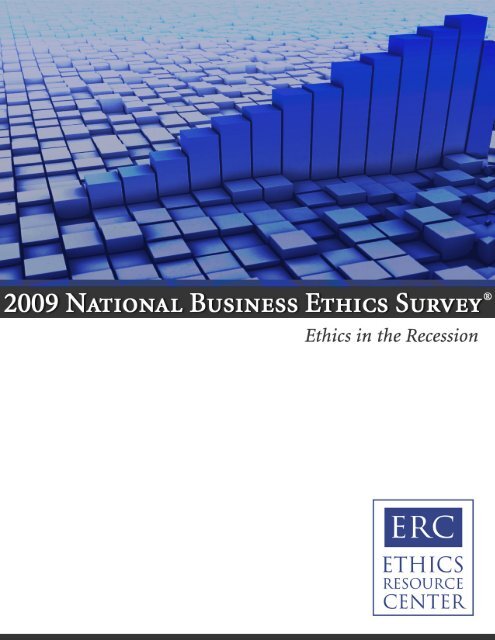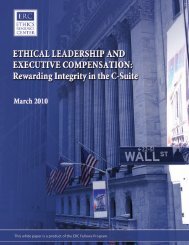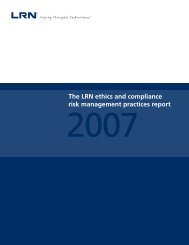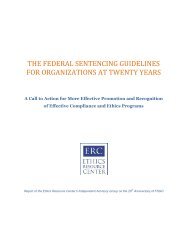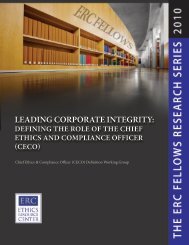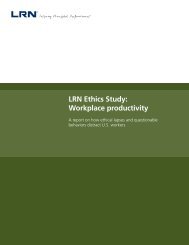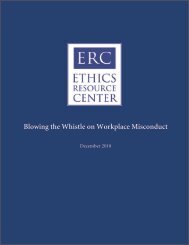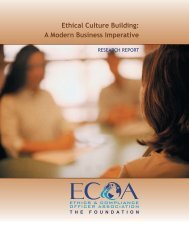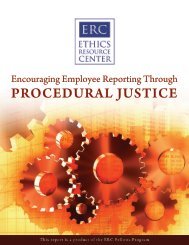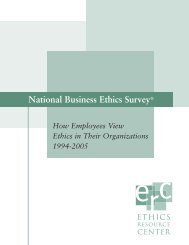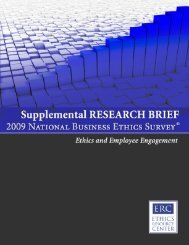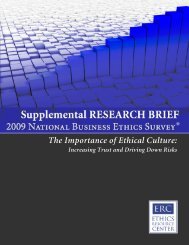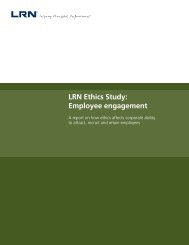The 2009 National Business Ethics Survey - Ethics Resource Center
The 2009 National Business Ethics Survey - Ethics Resource Center
The 2009 National Business Ethics Survey - Ethics Resource Center
- No tags were found...
Create successful ePaper yourself
Turn your PDF publications into a flip-book with our unique Google optimized e-Paper software.
Library of Congress Cataloging-in-Publication DataISBN 978-0-916152-16-1This report is published by the <strong>Ethics</strong> <strong>Resource</strong> <strong>Center</strong> (ERC). Allcontent contained in this report is for informational purposesonly. <strong>The</strong> <strong>Ethics</strong> <strong>Resource</strong> <strong>Center</strong> cannot accept responsibility forany errors or omissions or any liability resulting from the use ormisuse of any information presented in this report.©<strong>2009</strong> <strong>Ethics</strong> <strong>Resource</strong> <strong>Center</strong>.All rights reserved. Printed in the United States of America.This publication may not be reproduced, stored in a retrievalsystem, or transmitted in whole or in part, in any form or by anymeans, electronic, mechanical, photocopying, recording, or otherwise,without the prior written permission from the <strong>Ethics</strong> <strong>Resource</strong><strong>Center</strong>, 2345 Crystal Drive, Suite 201, Arlington, VA 22202USA.Additional copies of this report and more information about permissionand licensing may be obtained by calling 703-647-2185,or by visiting www.ethics.org.
Founded in 1922, the <strong>Ethics</strong> <strong>Resource</strong> <strong>Center</strong> (ERC) is America’soldest nonprofit organization devoted to the advancementof high ethical standards and practices in public andprivate institutions. For 87 years, ERC has been a resource forpublic and private institutions committed to a strong ethicalculture. ERC’s expertise also informs the public dialogueon ethics and ethical behavior. ERC researchers analyze currentand emerging issues and produce new ideas and benchmarksthat matter — for the public trust.For more information about ERC, please visit our website atwww.ethics.org.To contribute to ERC and its mission, please visit our websiteat www.ethics.org/donate.
Welcome to ERC’s <strong>2009</strong> <strong>National</strong> <strong>Business</strong> <strong>Ethics</strong> <strong>Survey</strong>®It is our distinct pleasure to present the <strong>Ethics</strong> <strong>Resource</strong><strong>Center</strong>’s trademark study, the <strong>2009</strong> <strong>National</strong> <strong>Business</strong><strong>Ethics</strong> <strong>Survey</strong> (NBES). This is the sixth in a series of reportsthat began in 1994. NBES has grown into a mainstay ofresearch on ethics in the American workplace and we aremost grateful, as always, for the support it receives fromthe contributors who make the NBES possible.
Foreword<strong>The</strong> two years since our last report, in 2007, have been a wild ride for the American economy and most all of usin it. We at ERC were more than a little curious to learn what impact the recession had on ethical behavior on thejob. This down economy was unique in recent times; we therefore thought the <strong>2009</strong> NBES would be like studyingworkplace ethics under extreme, laboratory conditions. Frankly, we expected to find plenty of negative trends.We were wrong – and pleasantly surprised. Overall, since the recession took hold in December 2007, things hadgotten better. Our key measures for observation and reporting of misconduct improved, as did the data for ethicalculture and perceived pressure to commit unethical acts. <strong>The</strong> anxieties of a shrinking economy did not translate, ingeneral, into a free fall in ethical behavior. Far from it.As we studied the results, we were prompted to look at earlier ERC data for another period of economic stress andscandal. We pulled out NBES surveys for 2000 and 2003 and compared trends. Those were the years when the dotcom bubble burst, when Enron blew up and Arthur Andersen went under, the stock market faltered, and a numberof CEO’s were suddenly facing prison terms. Paradoxically, workplace ethics improved. <strong>The</strong> suggestion is that, contraryto what one might expect, misconduct declines in turbulent economic times and rises when the pressure’s off.This year’s NBES looks at why that might be so.<strong>The</strong> <strong>2009</strong> NBES also illustrates the importance of a strong ethical culture – values, principles and support for doingthe right thing – inside an organization. Trust and confidence in our institutions is vital; our economy can’t operatewithout it. We tried in this year’s survey to get an inside look by gauging employees’ perceptions of transparencyand accountability in their companies. <strong>The</strong> data were positive and encouraging. <strong>The</strong> results make very clear thatwhere we find a strong ethical culture, we also find a sense of openness and responsibility at all levels of an organization.We found this year’s survey process even more fascinating than usual. We hope you find this report as interestingand useful as we believe it is. If you would like to become a financial supporter of the NBES, we would welcomeyour contribution. <strong>The</strong>re is room for more analysis of these data, and the 2011 NBES is just around the corner.Patricia J. Harned, Ph.D.ERC PresidentMichael G. OxleyChairman, ERC Board of Directors6©<strong>2009</strong> <strong>Ethics</strong> <strong>Resource</strong> <strong>Center</strong>
MethodologySince 1994, the <strong>Ethics</strong> <strong>Resource</strong> <strong>Center</strong> has fielded the <strong>National</strong> <strong>Business</strong> <strong>Ethics</strong> <strong>Survey</strong>® (NBES), a nationallyrepresentative poll of employees at all levels, to understand how they view ethics and compliance atwork.This <strong>2009</strong> report is the sixth in the series.NBES is the most exacting longitudinal research effort examining organizational ethics from the employeeperspective. <strong>The</strong> long-term nature of the study is important because it provides context for national trends.NBES is the only longitudinal study that tracks the views of employees at all levels within organizations toreveal real-life views of what is happening within organizations and the ethics risks they face.Over the years, ERC has polled more than 16,000 employees through its national ethics survey research,including NBES. In <strong>2009</strong>, 3,010 responses were collected. Review of the data revealed that 158 respondentsworked in the government sector. <strong>The</strong>se cases were removed from all analysis, meaning that 2,852 responseswere from employees in the for-profit sector.Participants in the <strong>2009</strong> NBES were 18 years of age or older; currently employed at least 20 hours per week fortheir primary employer; and working for a company that employs at least two people. <strong>The</strong>y were randomlyselected to attain a representative national distribution. All interviews were conducted via telephone, andparticipants were assured that their individual responses to all survey questions would be confidential.Interviews were conducted from July 20, <strong>2009</strong>, to August 27, <strong>2009</strong>.<strong>Survey</strong> questions and sampling methodology were established by ERC; data collection was managed bythe Opinion Research Corporation. Analysis by ERC was based on a framework provided by the FederalSentencing Guidelines for Organizations, the Sarbanes-Oxley Act of 2002, and professional experience indefining elements of formal programs, ethical culture, risk and outcomes.<strong>The</strong> sampling error of the findings presented in this report is +/- 1.8 at the 95 percent confidence level.In <strong>2009</strong> survey data were weighted by age and gender. In 2007, data for that year and prior survey yearswere weighted by age, gender and education. Rather than re-weight and recalculate past years’ data using<strong>2009</strong>’s weighting scheme, ERC has elected to report previous years’ results as published in 2007.For a detailed explanation of methodology and the methodological limitations of this report and demographicinformation on survey participants, visit www.ethics.org/nbes.©<strong>2009</strong> <strong>Ethics</strong> <strong>Resource</strong> <strong>Center</strong> 7
<strong>The</strong> NBES results also illustrate that executive compensation is much less an issue in a healthy ethical environmentmarked by transparency, accountability and a basic sense of fair play. More than 6 in 10 (62%) ofemployees believe that the compensation package for their CEO is appropriate. This perception, however,is linked to the ethical culture of the business.While it is welcomed relief in what has otherwise been a barrage of bad news this year, the implications ofthe <strong>2009</strong> data only surface by taking a longer view of the past 15 years of NBES study.Taken together, the data show that:We are experiencing an ethics bubble. <strong>The</strong> positive results of this study are likely to be temporary.We are beginning to see an important connection between workplace ethics and thelarger economic and business cycle: when times are tough, ethics improve.Executives who don’t elevate culture to a priority risk long-term business problems. NBESdata suggest that once the economy rights itself and business difficulties recede, misconductis likely to rise – unless a strong ethical culture is in place.©<strong>2009</strong> <strong>Ethics</strong> <strong>Resource</strong> <strong>Center</strong> 11
<strong>Ethics</strong> in the Recession<strong>The</strong> Background<strong>The</strong> <strong>Ethics</strong> <strong>Resource</strong> <strong>Center</strong> began collecting data in the mid-1990s to assessthe state of ethics in the American workplace. Its <strong>National</strong> <strong>Business</strong> <strong>Ethics</strong> <strong>Survey</strong>®has been in the field every two years since 2003. Including surveys in 2000and in 1994 1 , this new NBES marks the sixth in the series. NBES is the essentialtool ERC uses to collect national data and benchmark changes in employeeattitudes over time. It provides both longitudinal data and a look at employeeperceptions of topical issues of interest to researchers, management and employeesthemselves.In 2007, NBES benchmarking showed that key measures of workplace ethicshad declined since 2005. <strong>The</strong> drop was steep enough that ERC warned in itsreport that year that misconduct appeared to have returned to “pre-Enron levels.”2 We know now that within a few weeks of that report, in December 2007,the United States had begun to enter a severe economic recession that maybe ending only now, 24 months later. 3 What effect the recession has had onworkplace ethics is the focus of this year’s report._____________1. In 1994, the survey was entitled <strong>Ethics</strong> in American <strong>Business</strong>.2. ERC’s 2007 <strong>National</strong> <strong>Business</strong> <strong>Ethics</strong> <strong>Survey</strong>, p. 253. “Fed Chief Says Recession Is Very Likely Over,” <strong>The</strong> New York Times, Sept. 15, <strong>2009</strong>.12©<strong>2009</strong> <strong>Ethics</strong> <strong>Resource</strong> <strong>Center</strong>
<strong>The</strong> ResultsSurprisingly, instead of a worsening picture since 2007, the <strong>2009</strong> results turnedout to be remarkably positive. Despite the national turmoil, NBES discoveredimprovements in many of ERC’s key measures:Fewer employees said they had witnessed misconduct on the job;the measure fell from 56 percent in 2007 to 49 percent in <strong>2009</strong>More employees said they had reported misconduct when theyobserved it; 63 percent in <strong>2009</strong>, up from 58 percent in 2007ERC’s measures of the strength of ethical culture in the workplaceincreased from 53 percent in 2007 to 62 percent this year – a positivesignAnd overall, perceived pressure to commit an ethics violation –to cut corners, or worse – declined from 10 percent two years agoto 8 percent.Only retaliation against those who reported misconduct appeared to increase– a negative development.Percentage Point Changes in Key ERC Measures (2007-<strong>2009</strong>)7ppts 45ppts2ppts3pptsObserved MisconductReporting of Observed MisconductPerceived Pressure to Commit a MisconductPerceived Retaliation as a Result of a Report of Misconduct©<strong>2009</strong> <strong>Ethics</strong> <strong>Resource</strong> <strong>Center</strong>_____________4. Ppts = percentage points, or the difference between the 2007 and <strong>2009</strong> results. In this case regarding observation of misconduct, 56%minus 49% equals a seven percentage point decrease.©<strong>2009</strong> <strong>Ethics</strong> <strong>Resource</strong> <strong>Center</strong> 13
From its series of NBES surveys, ERC has collected data that show how a strongethical culture helps drive misconduct downward. 6In a weaker ethical culture, employees observe more misconduct. This is evident,again paradoxically, in the years of less confidence and more scandal andrecession.Perceptions of Weak Ethical Culture Strengthand Observed Misconduct (2000-<strong>2009</strong>)55%48%46%40%52%42%56%47%49%39%Observed MisconductWeak to Weak LeaningCulture©<strong>2009</strong> <strong>Ethics</strong> <strong>Resource</strong> <strong>Center</strong>2000 2003 2005 2007 <strong>2009</strong>Why does ethics awareness rise and ethical culture seem to grow stronger intimes of worry, anxiety and dislocation? One likely reason is that managementand supervisors talk more about ethical behavior or other subjects that are perceivedby employees to be ethics-related when the company’s well-being oreven its existence may be on the line. ERC data show that a company’s actionsmake a difference among its workforce. 7 Another reason may be that thoseprone to misbehave are less likely to take risks in a stressful time when managementis on higher alert._____________6. For example, in 2007 ERC found a 61 percentage point favorable difference in the level of observed misconduct when employeessay they work in a strong ethical culture. Source: ERC’s 2007 <strong>National</strong> <strong>Business</strong> <strong>Ethics</strong> <strong>Survey</strong>.7. Actions of management have been shown in ERC supplemental research to be a key driver of ethical culture. See “Reducing PerceivedPressure to Behave Unethically: <strong>The</strong> Roles of Leaders and Coworkers.” (ERC Fellows, July 2008)16©<strong>2009</strong> <strong>Ethics</strong> <strong>Resource</strong> <strong>Center</strong>
<strong>The</strong> Recession’s Impact on Standards and CultureA closer look at the <strong>2009</strong> results shows that, while overall results were surprisinglygood, some – although relatively few – said the recession had had a negativeimpact on ethical culture and standards.About one-quarter (22 percent) agreed that “the recession has negatively impactedthe ethical culture within my company.” And 10 percent said that “tostay in business during the recession, my company has lowered its ethical standards.”This erosion of culture had further implications. When employees felt that culturehad been negatively impacted, misconduct rose by 16 percentage points.Where ethical standards were lowered as a result of the recession, employeesobserved 23 percent more misconduct.Overall, 78 percent of those interviewed this year said that they or a colleaguehad been affected by company efforts to weather the recession. <strong>The</strong> surveyalso gathered data on what specific effects of the recession employees hadexperienced.Percent of Employees ExperiencingCompany Tactics to Weather the Recession (<strong>2009</strong>)42%Adjusted Work Schedules42%34%52%20%36%LayoffsCompensation or Benefit ReductionsHiring FreezesEarly Retirements or BuyoutsProduction Slowdowns©<strong>2009</strong> <strong>Ethics</strong> <strong>Resource</strong> <strong>Center</strong>12%Plant Closures©<strong>2009</strong> <strong>Ethics</strong> <strong>Resource</strong> <strong>Center</strong> 17
Even when employees didn’t say that their ethical culture had been negativelyimpacted by the recession, the tactics employed by their company did make adifference. Where employees were subject to recessionary tactics, misconductrose by 26 percentage points. Non-reporting rose by 15 percentage points.Percent of US Workforce Observing Misconductand Not Reporting Misconduct Based on Company Tactics (<strong>2009</strong>)100%80%60%40%20%29%55%24%39% No Company TacticsAt Least One CompanyTactic©<strong>2009</strong> <strong>Ethics</strong> <strong>Resource</strong> <strong>Center</strong>MisconductNon-ReportingCompanies that took actions affecting their employees clearly need to be alertto potential damage to their ethical culture and plan for repairs as the recessionfinally eases. 8_____________8. “Company tactics” refers to actions taken by companies to adjust to economic circumstances in the recession. For purposes of the NBESsurvey questionnaire, they included adjusted work schedules, layoffs, compensation or benefit reductions, hiring freezes, early retirements or buyouts, production slowdowns and plant closings.18©<strong>2009</strong> <strong>Ethics</strong> <strong>Resource</strong> <strong>Center</strong>
ERC then assessed what effect the impact of the recession had on ethical cultureand productivity. <strong>The</strong> data show that among companies that took measures toblunt the effect of the recession, such as layoffs, there was a measurable negativeimpact on employees’ sense that they work in an ethical environment. Itis imperative that company management help employees understand the necessityof these changes. Otherwise, employees are left to form their own perceptionsof the company – rightly or wrongly.Percent of US Workforce Perceiving Strong to Strong-LeaningEthical Culture Based on Company Tactics (<strong>2009</strong>)100%80%60%40%20%74%58%©<strong>2009</strong> <strong>Ethics</strong> <strong>Resource</strong> <strong>Center</strong>No Company TacticsAt Least One Company Tactic©<strong>2009</strong> <strong>Ethics</strong> <strong>Resource</strong> <strong>Center</strong> 19
Not only perceptions of culture are affected by these shake-ups. <strong>The</strong> amountof discretionary effort and attachment to the company that employees displayalso can be eroded. <strong>The</strong> more such actions a company took, the greater theperceived impact on employee engagement and productivity in the workplace.Percent of US Workforce Who Are Strongly Engagedwith Company and Job Based on Company Tactics (<strong>2009</strong>)100%80%60%40%88%81%73%67%©<strong>2009</strong> <strong>Ethics</strong> <strong>Resource</strong> <strong>Center</strong>20%0 CompanyTactics1-2 CompanyTactics3-4 CompanyTactics5+ CompanyTactics20©<strong>2009</strong> <strong>Ethics</strong> <strong>Resource</strong> <strong>Center</strong>
Transparency and Accountability<strong>The</strong> Background<strong>The</strong> recession economy in 2008 and <strong>2009</strong> affected thousands of American businessesand millions of employees and investors. <strong>The</strong> sheer size and scope ofthe crisis – as well as Washington’s massive response – begged new questions.<strong>The</strong> fundamental issue, on a grand scale, was trust. Lenders became highlyrisk-averse. Faith in some of the country’s biggest and most famed institutionsturned out to be misplaced. Consumer and investor confidence evaporated.(<strong>The</strong> Rasmussen index of investor confidence, which had reached its highestlevel ever at 150.9 on January 7, 2004, hit its lowest level ever at 52.5 on March9, <strong>2009</strong>.)<strong>The</strong> crisis quickly turned corporate “transparency and accountability” into aWashington buzz phrase and major policy focus. Investors questioned the accuracyof financial reports, the legitimacy of compensation packages receivedby executives, and the honesty of leaders when they appeared in public tooffer assurances. Congress and the new Administration, eager to restore confidencein the economy, set about imposing new standards for openness andresponsibility on businesses, especially among recipients of government bailoutfunds.What is transparency? A common definition of the term is the degree to whichan organization:provides public access to informationaccepts responsibility for its actions, andmakes decisions more openly 9_____________9. Ball, C. (<strong>2009</strong>). What Is Transparency? Public Integrity, 11(2), 293-307.©<strong>2009</strong> <strong>Ethics</strong> <strong>Resource</strong> <strong>Center</strong> 21
To which ERC would add:establishes incentives for leaders to uphold these standardsTransparency and accountability, intertwined, signal the trustworthiness of aninstitution and its leaders. When stakeholders are given information, governanceimproves.If one were looking for clues about transparency from inside an organization,then, we would find evidence that leaders:provide employees access to information that is relevant to thestrategic direction and performance of the companykeep their promises and commitmentsmake decisions more openlyaccept responsibility for wrongdoing, andreward performance that supports a transparent way of doingbusiness.ERC wanted to know if the inside – i.e., employee – perspective on corporatetransparency could tell us anything about how much we can trust companiesfrom the outside.As a result, the <strong>2009</strong> NBES included a number of questions designed to investigateemployee attitudes around the core issue of employee trust and perceptionsof openness of senior leaders. <strong>The</strong> inquiry extended to perceptionsabout whether executive compensation was fair and appropriate, whethermanagement was forthcoming about the financial health of the organizationand whether the U.S. government had gone too far or not far enough in intercedingin the private sector.22©<strong>2009</strong> <strong>Ethics</strong> <strong>Resource</strong> <strong>Center</strong>
Trust in LeadershipAs with NBES measures of the impact of the recession, the U.S. workforce gavea surprisingly positive picture of trust and confidence – especially given themonths of discouraging economic coverage by national and global news media.Aggregating the data from the transparency questions, ERC compiled an index.<strong>The</strong> results show that a strong majority of respondents – 71 percent – feelthat their workplace is open and informative and would meet most or all of thecriteria listed above. Twenty-nine percent had a more negative perception oftransparency in their workplace. 10 18%Perceptions of Top Management’s BehaviorsRelated to Transparency (<strong>2009</strong>)50%40%30%20%10%26%44%11%©<strong>2009</strong> <strong>Ethics</strong> <strong>Resource</strong> <strong>Center</strong>Strongly Open,InformativeSomewhat Open,InformativeSomewhat Closed,UninformativeStrongly Closed,Uninformative_____________10. Due to rounding, totals do not equal 100 percent.©<strong>2009</strong> <strong>Ethics</strong> <strong>Resource</strong> <strong>Center</strong> 23
ERC also calculated an accountability index based on answers to a series ofsurvey questions related to responsibility in an organization. An accountablebusiness operation would be one that confronts mistakes or misconduct andestablishes a system – including discipline or dismissal – to prevent a recurrence.Accountability in business – combined inextricably with transparency– is the basis for consumer, employee and investor trust.Nearly 80 percent of the interviewees said they work in an environment where,in practice, employees at all levels are held accountable to company standards.Perceptions of Accountability for All Levels of Management (<strong>2009</strong>)50%40%30%20%10%41%38%13%7%©<strong>2009</strong> <strong>Ethics</strong> <strong>Resource</strong> <strong>Center</strong>StronglyAccountableSomewhatAccountableSomewhatUnaccountableStronglyUnaccountable24©<strong>2009</strong> <strong>Ethics</strong> <strong>Resource</strong> <strong>Center</strong>
Interestingly, despite vast differences in disclosure externally, the <strong>2009</strong> NBESfound little difference in internal disclosure between publicly-traded and privately-heldorganizations on the questions of transparency and accountability.Principles of transparency and accountability are integral to ethical culture,which ERC describes as having four essential elements:Ethical leadership: leaders set the right “tone at the top” andmodel ethical culture as part of earning the trust of employeesSupervisor reinforcement: employees look to immediate supervisorsfor signs that the tone at the top is important and is takenseriouslyPeer commitment: peers talk about the importance of ethics andsupport one another in “doing the right thing”Embedded ethical values: a sense of “how we do things aroundhere” integrated into daily activitiesManagement that is open, informative and accountable sends a positive messageup and down the organization and affects perceptions in other areas, suchas executive compensation, that otherwise might be causes of discontent.©<strong>2009</strong> <strong>Ethics</strong> <strong>Resource</strong> <strong>Center</strong> 25
Executive CompensationAs some of the recession’s spectacular business failures illustrated, executivecompensation and bonuses can motivate senior executives to seek short-termgains and take excessive risks while ignoring or downplaying the long-termviability of the company.Yet employees are upbeat about the compensation received by their CEOs.Sixty-two percent of employees say that the compensation of their CEO is appropriate.Beyond the “appropriateness” of the boss’s pay package, NBES inquiredabout employee perceptions of this short-term, high-risk issue.Asked whether the top executive’s compensation package encourageslong-term or short-term success for the company, about62 percent said “both equally.” About 25 percent answered longtermand 13 percent said short-term.Does the chief executive’s compensation reward future-growthstrategies, past performance, or both equally? Seventy-three percentanswered “both equally,” 12 percent said past performanceand 15 percent replied future growth.On the question of whether the pay package encourages riskier,high-return strategies, 47 percent disagreed and 27 percentagreed. Twenty-six percent neither agreed nor disagreed.26©<strong>2009</strong> <strong>Ethics</strong> <strong>Resource</strong> <strong>Center</strong>
<strong>The</strong> data suggest that culture influences employee perceptions of transparencyand accountability, and vice versa. <strong>The</strong>se are attitudes about trust andfairness, as well as whether leaders are working toward the long-range growthand well-being of the enterprise. <strong>The</strong> stronger the ethical culture, the morelikely it is that employees believe that executive compensation is appropriate.Percentage of US Workforce Who Feel Executive’s Compensationis Appropriate, Based on Culture Strength (<strong>2009</strong>)100%80%60%40%91%69%45%©<strong>2009</strong> <strong>Ethics</strong> <strong>Resource</strong> <strong>Center</strong>20%20%Strong CultureStrong LeaningCultureWeak LeaningCultureWeak Culture©<strong>2009</strong> <strong>Ethics</strong> <strong>Resource</strong> <strong>Center</strong> 27
Similarly, the stronger the ethical culture, the more employees believethat high-risk strategies are not rewarded.Percentage of US Workforce Who Feel <strong>The</strong> CompensationPackage for Senior-Most Executive Rewards Safer, MeasuredReturn Strategies, Based on Culture Strength (<strong>2009</strong>)100%80%60%40%60%47%40%40%©<strong>2009</strong> <strong>Ethics</strong> <strong>Resource</strong> <strong>Center</strong>20%Strong CultureStrong LeaningCultureWeak LeaningCultureWeak CultureIn general, employee perceptions of executive pay – both its appropriatenessand its use as a motivator – were positive. This corresponds with the NBES findingsthat at this time, management is doing a generally good job of communicatingthe importance of ethical culture and creating an open, transparentenvironment.28©<strong>2009</strong> <strong>Ethics</strong> <strong>Resource</strong> <strong>Center</strong>
Accurate Financial ReportingExecutive compensation and transparency and accountability all have figuredin recent corporate scandals, bringing them to the renewed attention of policymakers. By addressing these issues, the pressure that results in “making thenumbers” will hopefully be reduced. Yet long before serious misconduct orcriminality might surface in the hard data of financial reports, there can alsobe cultural signs in the workplace that suggest trouble lies ahead. Some ofthese signs may be red flags for material misstatements of financial condition.Others may not indicate material fraud, per se, but amount to warnings thatquestionable activities are taking place. In NBES <strong>2009</strong>, these flags consisted ofthe following:Falsifying or manipulating financial informationOverriding routine procedures (altering cut-off revenue, holdingbooks open, misdating revenue)Ignoring unusual activities happening at higher levels (i.e. sideagreements, unusual business deals)Creating fictitious vendors or invoicesStealing or misappropriating assetsSubmitting false or misleading invoices to customersEntering into contracts that lack proper terms, conditions or approvalsViolating contract terms with customers or suppliers©<strong>2009</strong> <strong>Ethics</strong> <strong>Resource</strong> <strong>Center</strong> 29
We asked employees in areas of high risk for financial fraud about the extent towhich they observe activities that may be indicative of material fraud or questionableactions taking place. 11 Fourteen percent of those surveyed said theyhad seen behavior that constituted at least one of these red flags. Most employeesobserved only one behavior that constituted a red flag.Percentage of US Workforce Observing Red Flag Behavior (<strong>2009</strong>)85.6% Observed No Red Flags0.9% 6-8 Red Flags8.6% 1 Red Flag1.1% 4-5 Red Flags3.8% 2-3 Red Flags©<strong>2009</strong> <strong>Ethics</strong> <strong>Resource</strong> <strong>Center</strong>In some high-profile scandals and business failures, including those during therecent recession, these signs were present but went unreported – exactly thetype of lack of openness that undermines confidence. <strong>The</strong> <strong>2009</strong> NBES detectedthat this may still be the case. Of the group observing some type of red flag,30 percent said they did not report their observation._____________11. Employees in high-risk areas included executives, finance/accounting, internal audit, legal, procurement/contracts and sales.30©<strong>2009</strong> <strong>Ethics</strong> <strong>Resource</strong> <strong>Center</strong>
Government Intervention: Too Much or Too Little?<strong>The</strong> federal government’s response to the recession included massive bailoutsand major stimulus funding. In the case of major banks and auto makers, Washingtonintervened directly in governance and management of the troubledfirms. With the money has come vigorous and expanded enforcement by regulators,prosecutors and inspectors general. ERC wanted to explore the effects, ifany, of these aggressive steps on employee attitudes.Employees’ views about the need for government oversight were largely drivenby the ethical culture in their workplace. <strong>The</strong> weaker the ethical culture, themore employees believe they need government involvement.Percentage of US Workforce Who Feel <strong>The</strong> Federal GovernmentIs Currently Providing Too Little Oversight50%40%30%20%10%30%42%43%51%©<strong>2009</strong> <strong>Ethics</strong> <strong>Resource</strong> <strong>Center</strong>Strong CultureStrong LeaningCultureWeak LeaningCultureWeak Culture©<strong>2009</strong> <strong>Ethics</strong> <strong>Resource</strong> <strong>Center</strong> 31
Other Key Findings<strong>The</strong> following charts augment the findings discussed in the first two sections.Additional analysis on specific topics (i.e. reporting, retaliation, generationaldifferences) will be forthcoming through supplemental reports. Sign up to receiveERC’s supplemental releases by visiting our website at www.ethics.org.<strong>Ethics</strong> in the RecessionDespite the recession that overshadowed American business in <strong>2009</strong>, NBES revealedpositive trends when it comes to the state of workplace ethics. NBESmeasures these trends in overall ethics by examining key outcomes (or behaviors)that will change if a company is effectively adhering to high standards ofconduct. Specifically, these outcomes include observed misconduct, whistleblowing, retaliation for reporting and pressure to compromise standards in orderto perform one’s job. <strong>The</strong> following charts highlight key findings related tothose specific outcome measures.32©<strong>2009</strong> <strong>Ethics</strong> <strong>Resource</strong> <strong>Center</strong>
Observed MisconductNearly half (49%) of employees observed some type of misconduct taking placein the workplace. This percentage is based on employees’ indication that theyhave observed at least one of fifteen behaviors in the past 12 months. <strong>The</strong> fulllist of behaviors included 27 measures, as follows:Percentage of US Workforce ObservingSpecific Forms of Misconduct (2007-<strong>2009</strong>)BEHAVIORS <strong>2009</strong> 2007Company resource abuseAbusive behaviorLying to employees23% n/a22% 21%19% 20%Email or Internet abuseConflicts of interestDiscriminationLying to outside stakeholdersEmployee benefit violations18% 18%16% 22%14% 12%12% 14%11% n/a©<strong>2009</strong> <strong>Ethics</strong> <strong>Resource</strong> <strong>Center</strong>Health or safety violationsEmployee privacy breachImproper hiring practicesFalsifying time or expenses11% 15%10% n/a10% 10%10% n/a©<strong>2009</strong> <strong>Ethics</strong> <strong>Resource</strong> <strong>Center</strong> 33
Poor product qualityStealingSexual harassmentSubstance abuseDocument alteration9% 10%9% 12%7% 10%7% n/a6% 6%Misuse company’s confidential infoCustomer privacy breachEnvironmental violationsMisrepresent financial recordsAccept gifts or kickbacks*6% 6%6% n/a4% 6%4% 5%4% 4%©<strong>2009</strong> <strong>Ethics</strong> <strong>Resource</strong> <strong>Center</strong>Use competitor’s infoAnti-competitive practicesBribe public officialsInsider tradingIllegal political contributions2% 4%2% n/a1% n/a1% n/a1% n/a* In 2007, accepting/giving bribes, kickbacks and gifts was asked as one question.34©<strong>2009</strong> <strong>Ethics</strong> <strong>Resource</strong> <strong>Center</strong>
Recipients of Reports of MisconductAs noted on page 13, in <strong>2009</strong> the percentage of employees who reported misconductrose by 5 percentage points (a 9 percent increase over 2007). Overall,63 percent of employees who observed some form of misconduct reportedtheir observation. In 2007, NBES revealed that the majority of employees whoreported did so by talking with their direct supervisor or another member ofhigher management. In <strong>2009</strong>, the pattern remains the same. Most reports ofmisconduct are made to management.Recipients of Reports of Misconduct (2007-<strong>2009</strong>)Reporting Sources in 20075% Other3% External Source13% Other Responsible Person3% Hotline77% Management43% Direct Supervisor34% Higher ManagementReporting Sources in <strong>2009</strong>4% Other4% External Source15% Other Responsible Person3% Hotline75% Management46% Direct Supervisor29% Higher Management©<strong>2009</strong> <strong>Ethics</strong> <strong>Resource</strong> <strong>Center</strong>©<strong>2009</strong> <strong>Ethics</strong> <strong>Resource</strong> <strong>Center</strong> 35
Specific Forms of RetaliationFifteen percent of employees who observe and report misconduct perceivethey were retaliated against as a result. In <strong>2009</strong>, NBES asked employees aboutthe kind of retaliation they experienced. <strong>The</strong> majority of employees experiencedinterpersonal responses from their colleagues, rather than a direct impacton their job status or responsibilities.Specific Forms of Retaliation Experienced as a Resultof Reported Misconduct (<strong>2009</strong>)60%62%55%48%Other employees gave you acold shoulderYour supervisor or management excludedyou from decisions and work activityYou were verbally abused by yoursupervisor or someone else in managementYou almost lost your job42%43%27%20%You were verbally abused by other employeesYou were not given promotions or raisesYou were relocated or reassignedAny other form of retaliation©<strong>2009</strong> <strong>Ethics</strong> <strong>Resource</strong> <strong>Center</strong>18%4%You were demotedYou experienced physical harm to your person or property36©<strong>2009</strong> <strong>Ethics</strong> <strong>Resource</strong> <strong>Center</strong>
PressureOnly a small percentage of employees indicate in any given NBES year thatthey feel pressure to compromise ethics standards in order to do their jobs.Nevertheless, since 2000 NBES has been reporting a strong relationship betweenemployees’ indication that they feel such pressure and the extent towhich they observe misconduct taking place. In <strong>2009</strong>, this finding continued;86 percent of employees who felt pressure to compromise company standardsalso observed at least some form of misconduct taking place at work. In otherwords, where there is smoke, there is fire. Pressure is therefore an importantindicator that wrongdoing may be taking place.Consistent with most of the other outcome measures for <strong>2009</strong>, fewer employeessaid that they feel pressure to cut corners in order to do their jobs.Percentage of US Workforce Perceiving Pressureto Commit Misconduct (NBES <strong>Survey</strong> Years 1994-<strong>2009</strong>)30%28%*20%10%14%11% 11%10%8%©<strong>2009</strong> <strong>Ethics</strong> <strong>Resource</strong> <strong>Center</strong>19942000 2003 2005 2007 <strong>2009</strong>* Differences in the wording of the answer choices may account for the higher numbers in 1994©<strong>2009</strong> <strong>Ethics</strong> <strong>Resource</strong> <strong>Center</strong> 37
Transparency and Accountability<strong>The</strong> <strong>2009</strong> NBES included a new set of questions designed to investigate employeeattitudes about the transparency of senior leaders, especially when itcomes to providing information about the well-being of the company. Additionally,questions were asked about employee views of the compensation ofthe CEO, accountability to standards, and the need for more government oversightin business. <strong>The</strong> following information highlights key findings related tothose specific measures.Transparency, Accountability, Compensation & OversightOverall, employees indicate a positive view of the transparency and accountabilityof their leaders. Transparency and accountability were reported in thefirst section in the form of indices. Key results related to individual metrics wereas follows:In a measure of transparency, a high number – 80 percent – saidthey were satisfied with the information they were getting fromtop management about “what’s going on in my company.” Thiswas an uptick from 78 percent in the summer of 2007Seventy-four percent said they trusted that top managementwould keep their promises and commitments; this measure lostground from mid-2007, when 78 percent agreed with the statementBut when asked whether top management talks about the importanceof workplace ethics and “doing the right thing,” a full 89percent said yes – up 5 percentage points from the pre-recessionperiod two years agoAsked if they believed top managers would be held accountableif caught violating the organization’s ethical standards, 82 percentsaid yes, an increase of 2 percentage points38©<strong>2009</strong> <strong>Ethics</strong> <strong>Resource</strong> <strong>Center</strong>
<strong>The</strong> majority of employees were also remarkably positive about the compensationof their executives. Overall, 62 percent of employees strongly agreedor agreed that the compensation package for their senior-most executive wasappropriate. In 2007, ERC first asked employees about the appropriateness oftheir CEO’s pay. <strong>The</strong> question was repeated in <strong>2009</strong>.On the question of appropriate compensation for the seniormostexecutive, 62 percent agreed, a 4 percentage points risefrom 2007Other highlights of findings related to government oversight include the following:Answers were divided on government intervention: 41 percentthought there was too little oversight by the government, 38 percentthought there was too much oversightand 21 percent said the level of oversight was right©<strong>2009</strong> <strong>Ethics</strong> <strong>Resource</strong> <strong>Center</strong> 39
<strong>The</strong> Impact on Standards and CultureNBES research since 2000 shows that misconduct tends to decline in a strongethical culture where top managers talk often about the importance of ethicsand doing the right thing. <strong>The</strong> trend lines suggest a connection betweentransparency and accountability, on the one hand, and a decrease in unethicalbehavior.Percentage of US Workforce Perceiving Top ManagementTalks About <strong>Ethics</strong> and NOT Observing Misconduct(NBES <strong>Survey</strong> Years 2000-<strong>2009</strong>)84%45%87% 85%54%48%84%44%89%51%©<strong>2009</strong> <strong>Ethics</strong> <strong>Resource</strong> <strong>Center</strong>2000 2003 2005 2007 <strong>2009</strong>Top Management Talks About <strong>Ethics</strong>DID NOT Observe Misconduct40©<strong>2009</strong> <strong>Ethics</strong> <strong>Resource</strong> <strong>Center</strong>
Conclusions and RecommendationsSix years have passed since the <strong>National</strong> <strong>Business</strong> <strong>Ethics</strong> <strong>Survey</strong> has delivered such good news about thestate of ethics in American business. And while it is welcomed relief in what has otherwise been a barrageof bad news this year, the implications of the <strong>2009</strong> data only surface by taking a longer view of the past 15years of NBES study.Taken together, the data show that:We are experiencing an ethics bubble. <strong>The</strong> positive results of this study are likely to be temporary.We are beginning to see an important connection between workplace ethics and thelarger economic and business cycle: when times are tough, ethics improve. When businessthrives and regulatory intervention remains at status quo, ethics erode. We can expect thispattern to continue.Executives who don’t elevate culture to a priority risk long-term business problems. Ethicalculture is the single biggest factor determining the amount of misconduct that will takeplace in a business. Recent events have certainly revealed that poor decisions made by evena small number of employees can substantially damage not only a business, but the industryin which it operates. NBES data suggest that once the economy rights itself and business difficultiesrecede, misconduct is likely to rise – unless a strong ethical culture is in place. Leaderswho overlook this finding put their companies at risk.<strong>The</strong> way forward will require that business executives, directors and policy makers take several keysteps.For ExecutivesIt appears that one positive impact of the current business climate is that senior leaders are engagingin activities that employees perceive as “raising the bar” for ethical business conduct. You can continuethis progress in several ways.Prepare for the return of business as usual. Take note of the messages you are currentlysending to employees as you weather the storm of the recession. Measure the ethical cultureof your organization. If the findings are positive, heighten your current approach with employeesas business performance improves. <strong>The</strong> more you build a strong ethical culture, theless risk for misconduct your organization will face in the future.©<strong>2009</strong> <strong>Ethics</strong> <strong>Resource</strong> <strong>Center</strong> 41
Establish performance goals for senior managers on ethical leadership. Making ethicalleadership part of executives’ annual review reinforces the message that the organizationsupports and expects ethical conduct. Additionally, new evidence indicates that when managersare given goals specifically related to ethical leadership, they strengthen perceptions ofan ethical culture among their direct reports. 1Executives should also support the work of ethics and compliance professionals in their organizations (seebelow).For DirectorsEffective governance is an ethics issue as much as it is a fiduciary responsibility. From setting corporatepriorities to assuming business risk, the tone from the top really begins with directors. Boards can makeprogress by taking several steps:Create an ethics committee of the board. While the number of calls to the helpline and thesuccessful completion of compliance training may be matters most appropriate for the auditcommittee, the extent to which ethical standards truly govern high-level business decisionsis not. Boards should establish an ethics committee to monitor the activities of the board. Reviewdata measuring the ethical culture of the organization and ensure that ethical leadershipis a component of policy-setting and a priority for senior management.Recruit knowledgeable ethics professionals to serve on the board. Very few boards have atrained ethicist or a member knowledgeable about ethics. An ethics professional should be inthe room when strategy is being set and major decisions made.Establish financial incentives for ethical leadership by the CEO. An ethical culture is criticalto an organization’s long-term bottom line, yet few executives are reviewed and rewarded fortheir efforts to set a proper tone at the top. It is becoming common practice to assess ethicalculture in business. Boards should set performance goals for CEOs based on improvements inthose numbers.Directors should also request regular briefings on the ethics program from executives and ethics/compliance professionals in order to support their efforts._____________1. For example, companies adopting ERC’s metrics for ethical leadership as performance goals are beginning to show improvedorganizational cultures. Source: ERC’s survey client dataset.42©<strong>2009</strong> <strong>Ethics</strong> <strong>Resource</strong> <strong>Center</strong>
For Policy MakersPolicy makers and other market participants can encourage companies to operate with the highest integrityby doing the following:Emphasize culture and principles. Laws, regulations and rules are essential but they do notguarantee ethical conduct. Companies that establish strong cultures and reduce risk shouldbe rewarded. Attempts to encourage transparency and accountability in corporate Americashould be backed up by collecting data to track ethical leadership and culture change withinan organization. Metrics that gauge ethical culture lead to better outcomes and help predicttrouble spots.Encourage the creation of board ethics committees. Board oversight of efforts to build astrong ethical culture should be paramount to the responsibilities of executive compensation,governance and audit committees.Encourage disclosure about corporate ethical culture. In light of its importance in reducingrisk, investors deserve information about the well-being of a corporate ethical culture.Directors should also request regular briefings on the ethics program from executives and ethics/compliance professionals in order to support their efforts.For <strong>Ethics</strong> and Compliance ProfessionalsWhile tone begins at the top of a company, it is often ethics and compliance professionals who establishthe systems and provide resources to sustain an ethical culture. <strong>Ethics</strong> and compliance officers shouldtherefore:Focus on culture and collect data. Now is the time to assess your culture. Identify outliers inyour organization and work with leaders to improve their skills in ethical leadership. Add cultureto current assessments of your company ethics and compliance program, especially asthe recession eases and business performance begins to change. Use cultural metrics to tracktrends and discern patterns of misconduct, reporting, retaliation, openness and accountability.©<strong>2009</strong> <strong>Ethics</strong> <strong>Resource</strong> <strong>Center</strong> 43
Start with management, especially if your organization is taking recession counter-measures.<strong>The</strong> NBES results show that these tactics can help get a company through a crisis, yetthey erode employee perceptions of the ethics of their workplace. <strong>The</strong> <strong>2009</strong> data support previousNBES findings that managers are very influential in employee conduct and reporting.Focus on management in areas most affected by corporate efforts to address the recession.Prepare for the return to business as usual. <strong>The</strong> survey data suggest that ethics awarenessimproves in a crisis and that laxness returns when the crisis is past. Help executives preparefor the return in culture and employee conduct when business performance improves.In all, NBES research continues to show that ethics matters in business. <strong>The</strong> <strong>2009</strong> study was conductedduring an extraordinary time, and it is a period that we hope will not be repeated soon. However, it isthe challenge before us all to ensure that the good news we received about workplace ethics this yearis anything but extraordinary.44©<strong>2009</strong> <strong>Ethics</strong> <strong>Resource</strong> <strong>Center</strong>
Additional findings and methodology can be found atwww.ethics.org
For more information, please contact:<strong>Ethics</strong> <strong>Resource</strong> <strong>Center</strong>2345 Crystal Drive, Suite 201Arlington, VA 22202USATelephone: 703.647.2185FAX: 703.647.2180Email: ethics@ethics.orgVisit Our Website: http://www.ethics.org
<strong>The</strong> NBES Team<strong>The</strong> <strong>2009</strong> NBES is the result of a collaborative effort by the staff of the ERC:Patricia J. Harned, Ph.D., PresidentResearch and AnalysisLeslie Altizer, Senior Director of Benchmarking ServicesSkip Lowney, Senior ResearcherMike Adams, Senior ResearcherKatie Lang, Senior ResearcherProductionPhilip Smith, Vice President/CommunicationsGraphic design and online production by Paula Bongino, Senior Director of Interactive MediaContributorsERC reached out to colleagues in the field to help refine key content areas of the survey question set.<strong>The</strong>se individuals also helped draw conclusions once the data was received. ERC would like to thankthe following individuals for their input.Mark Royal, <strong>The</strong> Hay GroupScott Avelino, KPMGMargot Cella, <strong>The</strong> <strong>Center</strong> for Audit Quality©<strong>2009</strong> <strong>Ethics</strong> <strong>Resource</strong> <strong>Center</strong> 47
Ask about our workplace ethics surveysCall Leslie AltizerSenior Director of Benchmarking Services<strong>Ethics</strong> <strong>Resource</strong> <strong>Center</strong>571-480-4408 or email Leslie@ethics.org<strong>The</strong> <strong>Ethics</strong> <strong>Resource</strong> <strong>Center</strong> is devoted to independent research and the advancement of highethical standards and practices in public and private institutions. Visit www.ETHICS.org.
ERC has reserved several topics from the NBES study forfurther discussion in supplemental reports.To sponsor a supplemental report, please contactPat Harned at 703-647-2185To learn more, visithttp://www.ethics.org/nbes
This report was made possible in part by generous contributions from three principal sponsors:


